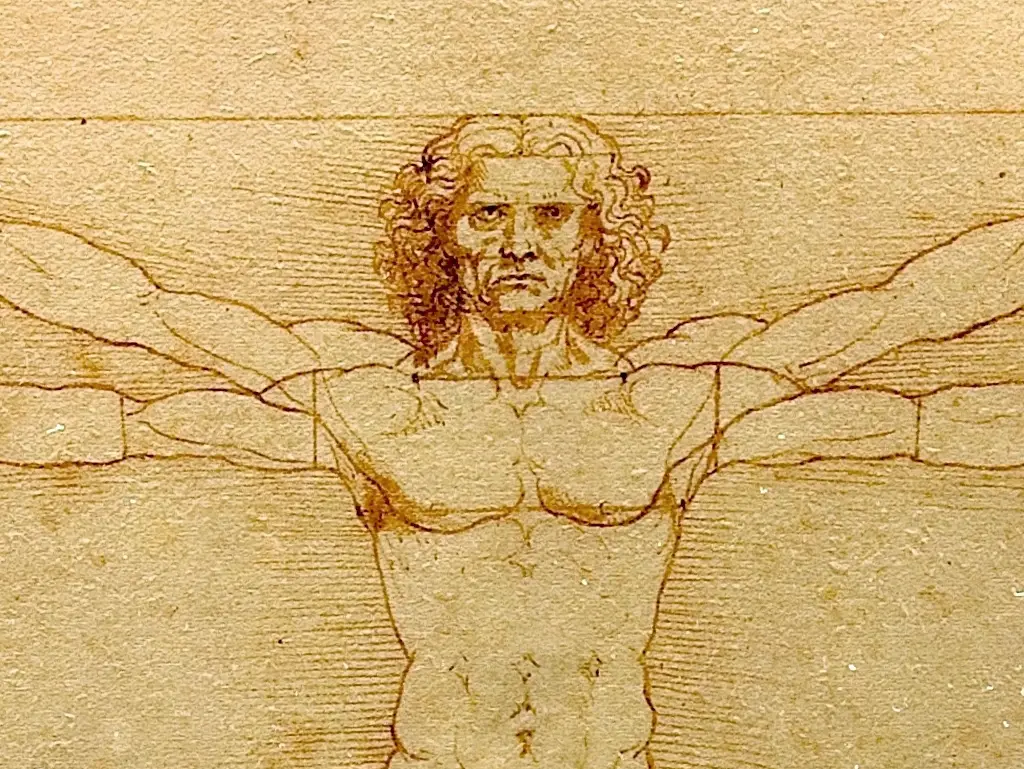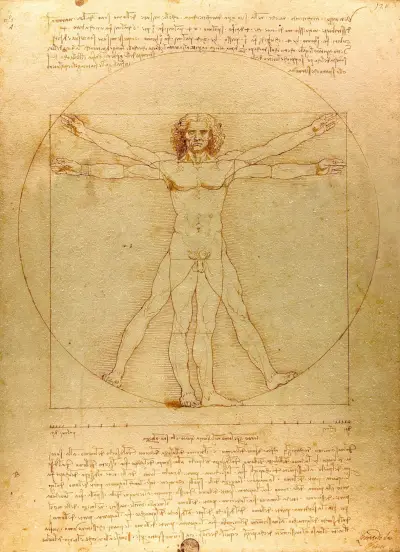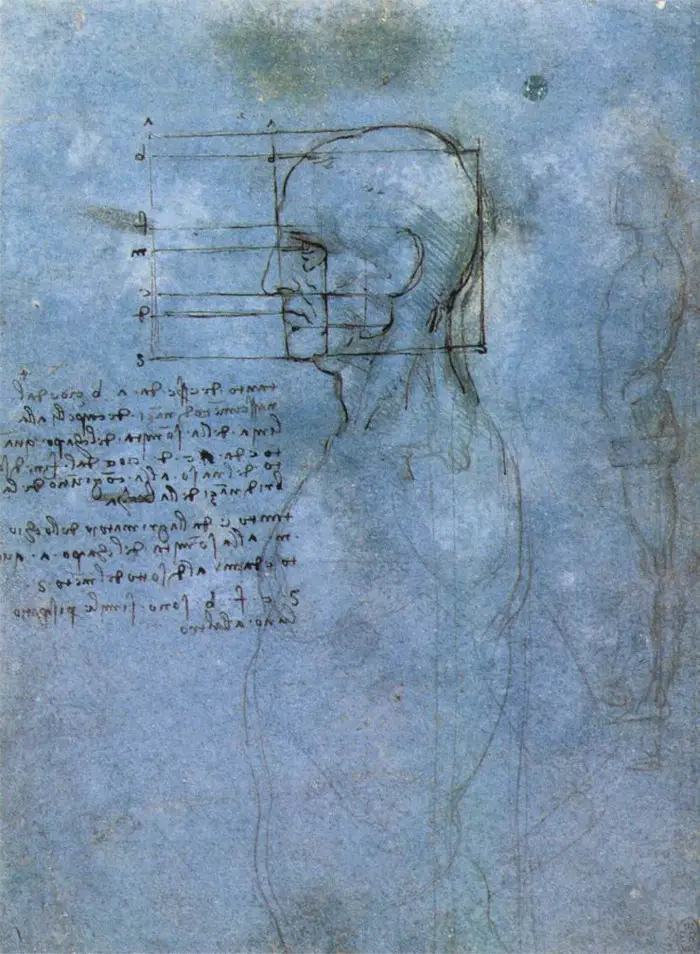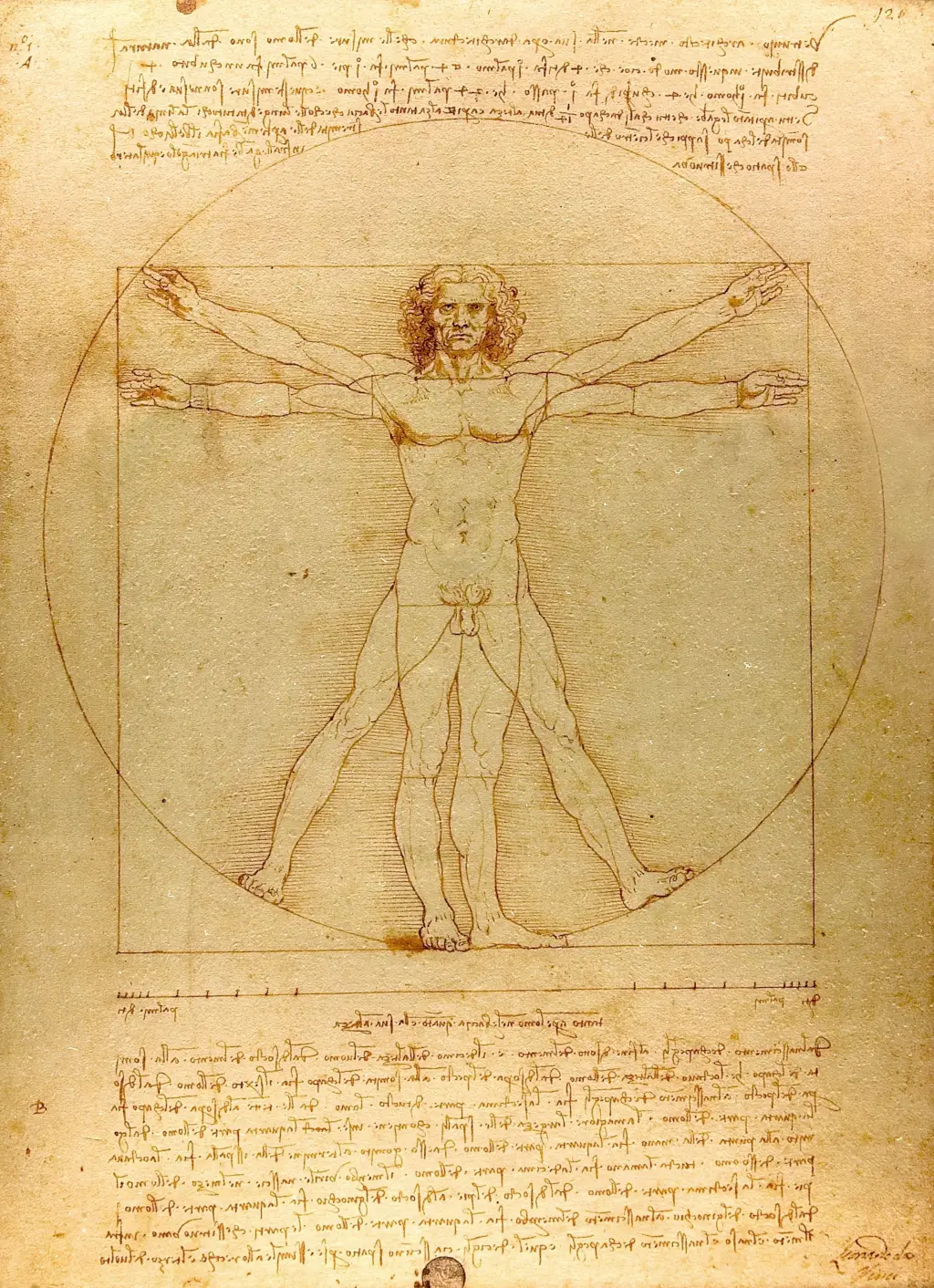Leonardo da Vinci's Vitruvian Man from around 1490 combines the disciplines of art, science and mathematics in what is considered to be perhaps the most famous drawing in the history of western art.
Introduction
The artist positions himself as the archetypal Renaissance Man with Vitruvian Man, taking influence from Roman architects of the past, and delivering a meaningful piece which compares the complexity and workings of man, with that of the wider world. This impactful piece has been reproduced in western culture more than almost any other artwork in history.
Da Vinci's Vitruvian Man was years in the making, with the artist developing his skills in the use of metalpoint several decades earlier, and also spending large amounts of time trying to undestand the intricacies of the human body. This drawing is therefore the most memorable element from a large focus on anatomy, proportion and perspective.
Whilst the artist was inspired by Roman architect Vitruvius, after whom the drawing was named, he did not blindly follow all of the teachings left behind in written word. He was one of a number of Italian architects and artists who was heavily influenced by Vitruvius, with a number of others having already produced something similar to Leonardo's own work.
The Renaissance Man would, of course, raise the bar with his own version, bringing an increased precision, thanks to his skills of observation, research and technical prowess. His understanding of Vitruvius's theories would also help him in other disciplines, such as engineering, where any action is caused by a series of designed components interacting with each other.
Leonardo wanted to take theories from the past and to update them with his own findings. He would treat the human anatomy in this drawing like an architectural design, carefully considering proportions and attempting to produce the perfect human figure in visual form. Alongside the precise drawing he added notes, in which he discussed Vitruvius' explanations, alongside his own findings.
Leonardo's Vitruvian Man enjoys a strong legacy, becoming not just an iconic image in it's own right, but also helping to inspire new generations of artists and engineers who marvel at the precision of work achieved so many centuries ago. It is the artwork which best reminds us of the rounded abilities of Da Vinci, both in terms of science and art, but also in how he addressed different disciplines within his career.
Within this article there is a background to the drawing itself, explaining the influences which fell upon Leonardo leading up to this piece. There is also technical information on the structure of the composition, its size and the mediums used in combination to deliver this famous piece. Additionally, the full provenance, of that that we are aware, is included below, along with some larger, high resolution images of the original artwork.
Table of Contents
- Introduction
- Background
- Who was Marcus Vitruvius Pollio?
- Description
- Theory and Meaning
- Golden Ratio Theory
- Studies of Proportion
- Provenance
- Value
- Date
- Size and Medium
- Large Images of the Vitruvian Man
- References
Background
Marcus Vitruvius Pollio would prove to be a great inspriration and influence upon Leonardo da Vinci, just as he had been on a number of other famous Italian artists and architects. He provided a structure through his writings which taught of how the internal workings of man represents the wider reality of Earth.
"...[Man's] body is an analog for the world..."
Paris Ms. A, Notebooks/JP Richter, taken from Walter Isaacson's Leonardo da Vinci
Vitruvius would discuss how a well-proportioned human figure could provide the basis for strong architectural design, were it laid out on the ground. We then start to see portraits, as with Vitruvian Man, whose proportions are precisely measured, and the drawing techniques mirror architectural techniques. One will immediately notice that in this drawing, with Leonardo providing horizontal and vertical guides to measure distances of the body.
Who was Marcus Vitruvius Pollio?
Vitruvius was a Roman engineer who wrote the influential publication "De architectura". He was forgotten for many centuries, before re-appearing within Italian artistic circle in the early 15th century. Many of the elements that he discussed in his books would be continued by Da Vinci within his own work, with Vitruvian Man offering a visual representation of that.
Vitruvius served as an engineer in the Roman army, and it was here that he was supported in his theories in order to bolster the war effort. He would design several artillery machines which would be used in combat, including in the likes of Africa and Europe. He would later concentrate on his writing, which came from an architectural standpoint, in which much of his knowledge was derived. The comparison to Da Vinci's career cannot be understated, and he may well have been the main inspiration behind Leonardo's decision to spread his interest into multiple disciplines, becoming the "Renaissance Man".
Description
Leonardo da Vinci's Vitruvian Man displays a Nude Man placed centrally within the composition, with his arms and legs outstretched, as if lying flat on the floor. The full length figure has two sets of arms and legs, indicating the same model in two different poses. Firstly, his legs are wide open, and in the single they are closer together, but pointing slightly to one side.
His arms are spread out horizontally, as well as a second pair of arms which are lifted slightly higher, with the tips of the fingers in line with the top of the Vitruvian Man's head. The male figure is impressively toned, but facially looks almost middle aged, perhaps around the late thirties, just as the artist was at the time. His main muscle structure is included, but without the fine detail of anatomy that the artist used elsewhere in his studies.
The artist would label this drawing as "Le proporzioni del corpo umano secondo Vitruvio" which translates into English as The Proportions of the Human Figure after Vitruvius, or Proportional Study of a Man in the Manner of Vitruvius. The artwork has since become something of an iconic image, and has become better known by the simpler title of Vitruvian Man.
The male figure is balanced within a circle and a square, both of which are carefully used to layout the design, and ensure that proportion ratios are correctly delivered. There is also some light shading around the outline of his body, helping the figure to stand out. The man's muscular chest is particularly pronounced, whilst his curly hair also attracts our attention.
There is a series of notes added above and below the main composition, as well as a signature in the bottom right corner, plus a stamp closer to the centre of the bottom of the drawing. Areas of the paper have inevitably developed variations in tone in the centuries that have passed since the artist produced Vitruvian Man in around 1490.
Techniques
The Vitruvian Man was far away from the expressive work found in some of the other genres in which Da Vinci was involved. There are no corrections, or feint lines of experimentation, meaning that the piece was carefully planned well before he started work on this small piece of paper.
The artist used metalpoint initially, a medium which he had become very comfortable with, and had produced many of his early drawings with. This format does not allow for amendments, and so he had already learnt to be disciplined and well organised. He combined this with a compass and calipers, as if planning an architectural structure.
Theory and Meaning
Leonardo left behind a plethora of notes which run alongside his many anatomical drawings, giving us a helpful insight into the theories behind his work. He continued the ideas of Vitruvius, updating some of the calculations with his own research. He always wanted this drawing to represent human perfection, almost approaching divinity, whilst combining art and science together.
By the time of Vitruvian Man, Leonardo da Vinci had dissected the human face and body into its smallest of components, attempting to understand how it all fitted together and functioned. He understood the theory that the components of the human body symbolised the wider world, and this drawing represents that meaning perfectly.
Was Vitruvian Man a Self Portrait?
Many have speculated as to whether the Leonardo da Vinci's Vitruvian Man was actually a self portrait. It cannot be denied that the figure is approximately the same age that the artist would have been, around his thirties. In terms of physique, and facial features, however, much of what we see is the standard appearance favoured by the artist, something that could be re-used for other portraits as a default structure.
Leonardo regularly portrayed young man as lean, muscular individuals, and so this continues that approach. He also use long, curly hair in other portrait drawings. We also have relatively few visual clues as to his own image with which to compare Vitruvian Man too, leading most academics to reject this suggestion that the drawing was a self portrait. Much more likely to have been a self portrait was his Portrait of a Man in Red Chalk.
Golden Ratio Theory
Leonardo da Vinci was devoted to understanding more about anatomical proportions, and spent many hours studying this in order to make his paintings, sculptures and drawings as accurate as possible. Some have suggested that he used the Golden Ratio in his calculations, potentially in Vitruvian Man and the Mona Lisa, but these claims have generally been rejected.
Most academics have concluded that neither of those compositions match the Golden Rule theory, and that Da Vinci's own work was far more pragmatic, based on the research that he had carried out himself. The proportional ratios that he noted on Vitruvian Man were specific, absolute values. He did also produce an illustration of a dodecahedron from Pacioli's Divina proportione, which caused some of the speculation from later centuries, but is ultimately unfounded.
Studies of Proportion
Leonardo would sometimes be criticised for the lengths he would go in his studies of proportion. Fellow artists would accuse him of wasting time and being distracted from the main artistic tasks at hand. He did not care for these views, and continued to thrive for knowledge and understanding which would ultimately improve his work across a number of disciplines.
His preparations for a monument brought about studies in proportion, in which he measured up a number of local young men. From this he would calculate average ratios between the different parts of their bodies, before sketching out some of these findings on paper. He would begin this process not long before Vitruvian Man was put together, and eventually he reached a point where he was satisfied with his calculations, moving on to alternative postures for his models.
Studies in proportion had appeared in Italy several decades before the era of Da Vinci, but he would bring greater precision to what had passed before. Science was thriving at this time, and Da Vinci felt he could merge elements of it with art, to combine beauty with accuracy. Few shared his commitment to excellence, and his hard working nature would eventually ensure an impressive and influential legacy.
Provenance
The provenance regarding Vitruvian Man is unusually accurate, by the standards of Da Vinci's career. We can accurately track its path from the late 16th century up to the present day. The only doubt regards who initially held the piece after the artist had died, as he never actually sold the drawing.
It is likely to have been passed on to one of his students, but by the end of the 16th century was documented under the ownership of Cardinal Cesare Monti, before passing through several heirs. It was later purchased by Giuseppe Bossi, just as knowledge around Da Vinci's drawings was starting to spread, and then later sold on again to Luigi Celotti in the early 19th century.
Location
By 1822, the Vitruvian Man drawing would become a part of the collection of the Gallerie dell'Accademia in Venice, Italy, where it has remained ever since. Its fragility, as with most of Da Vinci's remaining drawings, has ensured that it is not normally allowed out on loan.
Condition
Renaissance drawings were never intended to last more than five hundred years, and so the items that have survived to the present day are now considered exceptionally fragile. Vitruvian Man is no different in that regard, and efforts are made to balance its preservation, whilst still allowing the public to see it in person.
Oil paintings and sculptures offer more opportunities in terms of restoration, so long as the original wood panels or stone work remains in place. With drawings such as this, light must be kept to a minimum and the paper itself also becomes liable to ripping or curling over time, as well as altering in tone.
Value
Leonardo's Vitruvian Man is highly unlikely to ever come up for sale. However, it if did, it might expect a high valuation, when considering all of its many qualities. It remains one of the most famous drawings in history, developing something of an iconic status within the history of art.
The item holds historical value in showing man attempting to develop an understanding of science, and specifically the human body. The piece has also received strong exposure in modern culture, featuring in a number of films, books and television programmes. However, its importance to the cultural scene in Venice, and more widely Italy, would make it unlikely to ever be sold at auction.
Date
The Vitruvian Man was completed by Leonardo da Vinci in circa 1490. Most of the artist's work is given a wider date than this, making a specific year relatively precise. Some historians have dated the piece more roughly at 1487-1490, as the artist was working on proportion studies throughout this period and in their opinion there is not enough evidence to point to a specific year within that span of time.
Most of these estimations on date take into account the way in which Virtuvian Man was completed, with pen and ink over an earlier use of metalpoint. They have also studied the techniques used within the drawing and found some clear similarities with other drawings from that period. The earliest estimate for the piece would be 1485, from any wellknown, trusted historian of the past century.
Size and Medium
Leonardo da Vinci's Vitruvian Man measures 34.4 cm in height, by 24.5 cm in width (13.5 in × 9.6 in). The artist used a combination of pen and brown ink with touches of watercolor over metalpoint for this artwork, which was delivered on a single paper page.
Pen and ink versus metalpoint were two very different drawings tools, each offering their own advantages. The artist chose metalpoint in his early years, and this medium taught him discipline and precision because of the difficulty in making amendments using this art form. Pen and ink then appeared more frequently, and allowed the artist to work in a freer, more expressive manner.
The artist chose to lay the foundations first in metalpoint, and thus ensuring that the proportions were correct, prior to decorating the artwork in pen and ink flourishes. Normally, he would not mix drawing mediums in this manner, until perhaps the last decade of his career.
Large Images of the Vitruvian Man
The precise detail incorporated by Leonardo da Vinci in his Vitruvian Man drawing can be seen below in our larger, high resolution images of the original piece. There is a zoomed-in image of the head area, as well as the full composition just underneath. The piece remains one of the most famous drawings in history, and amongst the most respected and influential items to have come from this artist's career.
 Close-up of the head of the Vitruvian Man
Close-up of the head of the Vitruvian Man
References
- Leonardo. The Complete Paintings and Drawings, Frank Zöllner & Johannes Nathan, Taschen
- Leonardo da Vinci, Walter Isaacson




 Leonardo da Vinci.jpg)

 Full Composition in Detail
Full Composition in Detail
